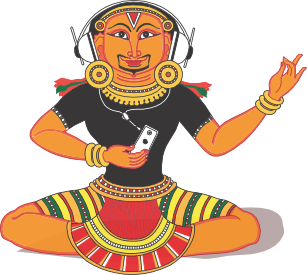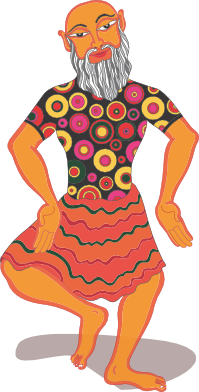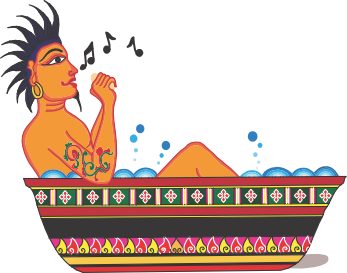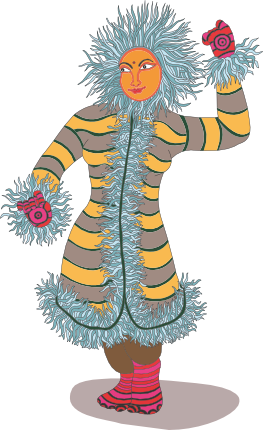




Posted by admin in Dance
on Jul 19th, 2012 | 0 comments
Kūchipūḍi
Kūchipūḍi is the classical dance form from the South-Eastern state of Āndhra Pradheśh. It derives its name from the village of Kuchélapuram, a small village about 65 kms from Vijayawāḍa. It is known for its graceful movements and its strong narrative dramatic character.
 History: Kūchipūḍi has been derived from the Bhāgavatha Méḷas, a dance drama form. Bhāgavatha Méḷā and Kūchipūḍi are arts that came into existence in the 15th-16thcentury during the Bhakthi movement. The great Bhaktha Siddhéndhra Sāmi Yōgi settled in the village of Kuchélapuram and started teaching the art form. He instructed Brahmin boys in devotional dance dramas based on religious themes. These religious plays were presented as offerings to god in accordance to the traditions of the Nāṭya Śhāsthra. The performers were called Bhāgavathulus. Only men performed this dance form. Kūchipūḍi flourished as a dramatic form of dance for hundreds of years. It was held in high esteem by the rulers of the Deccan. For instance Thānā Śhāh in 1678 granted the lands around Kūchipūḍi to the Brahmins who performed the dance.
History: Kūchipūḍi has been derived from the Bhāgavatha Méḷas, a dance drama form. Bhāgavatha Méḷā and Kūchipūḍi are arts that came into existence in the 15th-16thcentury during the Bhakthi movement. The great Bhaktha Siddhéndhra Sāmi Yōgi settled in the village of Kuchélapuram and started teaching the art form. He instructed Brahmin boys in devotional dance dramas based on religious themes. These religious plays were presented as offerings to god in accordance to the traditions of the Nāṭya Śhāsthra. The performers were called Bhāgavathulus. Only men performed this dance form. Kūchipūḍi flourished as a dramatic form of dance for hundreds of years. It was held in high esteem by the rulers of the Deccan. For instance Thānā Śhāh in 1678 granted the lands around Kūchipūḍi to the Brahmins who performed the dance.
In the early 1900s Védhāntham Lakshmīnārāyaṇa Śhāsthri changed the dance form’s stylistic direction. He moved from the little village of Kūchipūḍi, the birth place of this art form, to the larger metropolis Chennai a major center for art and culture in India. His talent and brilliance was immediately recognized. He introduced women to Kūchipūḍi and choreographed several solo dances, which have become part of the Kūchipūḍi repertoire today.
Apart from the stylistic differences between Kūchipūḍi and Bharathanātyam, there are certain types of dances that are unique to Kūchipūḍi. The Tharaṅgam in Kūchipūḍi is unique, for the dancer must dance on a brass plate, placing the feet on the raised edges. The dancer moves on the plate with as much balance as dancing on the ground. The dancer, besides dancing on a plate, carries oil lamps in each hand and balances a small vessel with water on his/her head. At the end of the performance, the dancer extinguishes the lamps and washes his/her hands with the water from the vessel.
Costumes: The Kūchipūḍi costumes and jewellery are very similar to those of Bharathanātyam.
Compiled by: Aarthi Natarajan & Indira Kadambi





 History: Kūchipūḍi has been derived from the Bhāgavatha Méḷas, a dance drama form. Bhāgavatha Méḷā and Kūchipūḍi are arts that came into existence in the 15th-16thcentury during the Bhakthi movement. The great Bhaktha Siddhéndhra Sāmi Yōgi settled in the village of Kuchélapuram and started teaching the art form. He instructed Brahmin boys in devotional dance dramas based on religious themes. These religious plays were presented as offerings to god in accordance to the traditions of the Nāṭya Śhāsthra. The performers were called Bhāgavathulus. Only men performed this dance form. Kūchipūḍi flourished as a dramatic form of dance for hundreds of years. It was held in high esteem by the rulers of the Deccan. For instance Thānā Śhāh in 1678 granted the lands around Kūchipūḍi to the Brahmins who performed the dance.
History: Kūchipūḍi has been derived from the Bhāgavatha Méḷas, a dance drama form. Bhāgavatha Méḷā and Kūchipūḍi are arts that came into existence in the 15th-16thcentury during the Bhakthi movement. The great Bhaktha Siddhéndhra Sāmi Yōgi settled in the village of Kuchélapuram and started teaching the art form. He instructed Brahmin boys in devotional dance dramas based on religious themes. These religious plays were presented as offerings to god in accordance to the traditions of the Nāṭya Śhāsthra. The performers were called Bhāgavathulus. Only men performed this dance form. Kūchipūḍi flourished as a dramatic form of dance for hundreds of years. It was held in high esteem by the rulers of the Deccan. For instance Thānā Śhāh in 1678 granted the lands around Kūchipūḍi to the Brahmins who performed the dance.